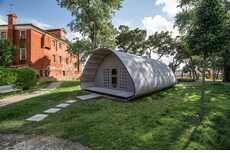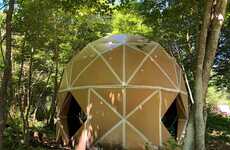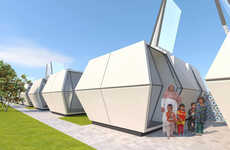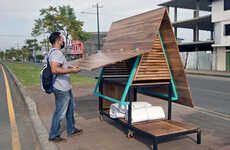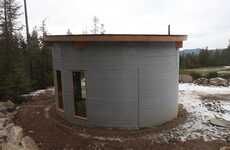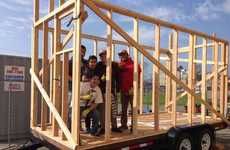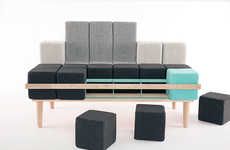
These Modular Shelters are Made from Brick Rubble
Katherine Pendrill — August 12, 2015 — Art & Design
References: architectmagazine & magazine.good.is
Architect Shigeru Ban helped to design a modular shelter that is made from leftover earthquake rubble. When a 7.8 magnitude earthquake hit Nepal earlier this year, the country faced a massive shortage of emergency housing. Ban came up with a solution to the problem by drawing up designs for a shelter that makes use of the rubble left behind by the earthquake.
Ban's modular shelter features a basic wooden framework that is designed to be filled in with brick rubble from buildings that were destroyed by the natural disaster. The shelters are fairly small, but they are designed for easy assembly. In the wake of an earthquake, city residents can stack leftover bricks inside the wooden frames and then cover the shelter with roof trusses made from paper tubes and plastic sheets. The shelters even mirror traditional Nepalese architecture, ensuring that the residents are as comfortable as possible in the temporary homes.
Ban's modular shelter features a basic wooden framework that is designed to be filled in with brick rubble from buildings that were destroyed by the natural disaster. The shelters are fairly small, but they are designed for easy assembly. In the wake of an earthquake, city residents can stack leftover bricks inside the wooden frames and then cover the shelter with roof trusses made from paper tubes and plastic sheets. The shelters even mirror traditional Nepalese architecture, ensuring that the residents are as comfortable as possible in the temporary homes.
Trend Themes
1. Modular Rubble-based Shelters - There is opportunity for the development of modular and customizable shelter solutions made from locally sourced waste materials, particularly in earthquake-prone areas.
2. Sustainable and Disaster-resilient Architecture - There is increasing demand for the development of cost-effective and sustainable emergency shelters that are resilient to natural disasters; innovative architects and builders can leverage green technologies and locally sourced materials to build highly adaptable resilient structures.
3. Localized Waste Material Upcycling Solutions - There is an opportunity for entrepreneurs and companies to develop localized waste upcycling solutions that can effectively contribute to rebuilding efforts in disaster-prone areas.
Industry Implications
1. Construction and Architecture - Companies in the construction and architecture industries can leverage the use of locally sourced materials to build disaster-resilient and sustainable homes that can reduce environmental impact and increase social equity.
2. Sustainability and Waste Management - Innovative waste management companies and sustainability-focused organizations can develop cost-effective solutions for upcycling locally sourced waste materials into building components.
3. Emergency and Disaster Relief - Emergency response companies can employ low-cost materials to construct immediate shelter solutions that can help victims quickly, especially during times of crisis.
4.3
Score
Popularity
Activity
Freshness


